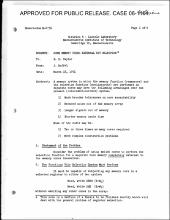| dc.contributor.author | Raffel, J. | en_US |
| dc.date.accessioned | 2009-06-12T22:13:51Z | |
| dc.date.available | 2009-06-12T22:13:51Z | |
| dc.date.issued | 1954-03-18 | en_US |
| dc.identifier | MC665_r13_M-2736 | en_US |
| dc.identifier.uri | http://hdl.handle.net/1721.3/40350 | |
| dc.description.abstract | A memory system in which the memory functions (remanence) and the selection function (nonlinearity) are performed in separate cores may have the following advantages over the present (coincident-current) system:
1) Much broader tolerances on core acceptability
2) Reduced noise out of the memory array
3) Larger signals out of memory
4) Shorter memory cycle time
Some of the costs may be:
1) Two or three times as many cores required
2) More complex construction problems | en_US |
| dc.language.iso | en | en_US |
| dc.publisher | Lincoln Laboratory - Division 6 | en_US |
| dc.relation.ispartofseries | MIT DIC 6889 | en_US |
| dc.relation.ispartofseries | Project Whirlwind Memo M-2736 | en_US |
| dc.relation.ispartofseries | Project Whirlwind Collection, MC665 | en_US |
| dc.title | Core Memory Using External Bit Selection | en_US |
| dc.type | Technical Report | en_US |

